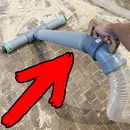Introduction: Kitchen With Many Cool Features
Have you ever wondered what it takes to build a kitchen completely from scratch? Do you need thousands of dollars worth of tools and decades of experience? The answer is NO! With just a few basic tools you can build a beautiful kitchen from plywood! Don´t believe me - well take a look!
I am a guy who really loves woodworking and when you do something with great passion people start to notice it. A thing that was once a hobby has become a small business. I am getting more and more requests to build custom furniture. One of the most recent ones was this kitchen that I built for my parents.
One day my mother explained to me that they are in a desperate need for some kitchen cabinets. They had the vision and I had the skills. The best part was that they wanted "as many cool features as I can come up with." This was a dream come true! All those years of Pinterest surfing weren´t for nothing.
Follow me along and I will show you all the cool features that I came up with and how I built it all!
Now, if you enjoy the video and the article, maybe give it a vote in the Plywood contest. This would make my day! You can find the vote button at the end of this ´ible.
Step 1: Tools and Materials
A kitchen could be built with just two power tools - a cordless drill and a track saw. These are a must but having other tools can make life much easier and open new possibilities.
These are the tools needed:
- Cordless drill (must) with bits and drill bits
- Track saw (must)
- Impact driver (for screws - cordless drill for drilling.
- Jig saw
- Miter saw
- Measuring and marking tools
- Finishing/painting tools
- Personal protection
- Big open space (not really a tool but still very important when building something that large)
Materials
- Plywood - I used higher grade plywood for visible parts and lower grade for not visible parts of the kitchen. I used 18mm birch plywood for everything except for the drawers that were built from 12 mm plywood. I used 5 sheets of 18mm and 2 sheets of 12 mm plywood.
- Adjustable furniture legs
- Drawer slides/hinges
- Handles
- Paint/oil/lacquer for finishing
- Different screws
I would recommend really just visiting a furniture shop for ideas. I got lots of ideas from there. Also, you will most likely find all the hardware from there.
The most important thing to have is the concept of what you are going to build. Take the measurements and make a sketch. I really recommend a free program called Sketchup for that. It is quite easy to learn and it makes visualising your work much much easier. Check out my drawing of the kitchen. It´s not quite how the kitchen ended up being because I like to spend my time building and not so much planning.
PS: I do apologise when some of the photos are out of focus. I think my camera has had a bit too much sawdust and needs cleaning. :)
Attachments
Step 2: Making the Sections
To begin with, I made all the sections. The typical height of kitchen surface is 900 mm. From that, I subtracted the thickness of the countertop (30mm) and the height of the adjustable legs (100mm) and was left with 770 mm. In my case, the countertop was already there and two sinks were installed as well. This meant that I had to build everything to fit around that. My parents found 3 nice trashcan systems that were already on slides and just needed a front face. Those I built under the sink. On the right-hand side of the trashcans was the dishwasher, on the left a spot for drawers and the corner section. On my original plan, I did not have anything planned next to the dishwasher but as I started building I realised I had just enough room to make a vertical drawer for spices and stuff like that.
The plywood I used was lower grade (C) because it would not be visible anyway. Only parts visible would be the edges which look the same on any plywood. I cut the pieces out with a track saw. I really recommend using a guided saw for this build. I purchased mine just before this build and it has become my favourite tool! The jig saw I used for finishing the cuts - to cut a smaller section from a whole sheet you need to make the cut a bit longer than the actual piece. This results in minor material loss by cutting into the material you do not need. To avoid that I made the cut exact and finished it with a jig saw.
Believe me or not but I did not use any glue on this kitchen build. Every connection was made with screws. My only advice is to not put the screws to close to the edge or you will run a risk of delaminating and spitting the plywood. It seemed to be okay to put the screws in 1 inch or 2 fingers widths from the edge.
After all the sections were ready I did also add adjustable legs - every section got at least four.
Step 3: Drawers
Building drawers is nothing too complicated. Of course, it could be done in a very complex way but why bother? I have always made drawers by screwing the sides together and then just adding a bottom. Only screws - no glue. So far I have yet to experience a drawer malfunction. When calculating drawer width measure the opening and subtract two times the thickness of the slides. In my case, it was 2X13 mm.
When installing the slides in the cabinets it is a good idea to make spacer blocks to get all the slides parallel. On the drawer side, I put the slides exactly in the middle but it really does not matter where you put them if they are both on the same height.
Step 4: Front Faces
Next up, I cut out and attached all the drawer faces. As I said earlier this was made from nicer plywood. My idea for attaching them was to glue the faces onto the drawers and then add some screws from the inside. I have done this way several times but it did not seem to work out on this project. I first tried using double-sided tape but it turned out to be too thin. Hot glue was no good either so I ended up nailing the faces on with a few nails and then added the screws. I was making sure to leave an even gap all around using spacers.
One of the sections had a door on hinges. This was a first-timer for me to install euro hinges but it worked out really nicely. I just did a couple of tests to get the hole location right. You need a 35 mm forstner bit to install euro hinges. The ones I used were soft-close and worked really nicely.
Probably the trickiest part was attaching the plywood to the dishwasher. I think I removed the front face of the dishwasher at least a dozen times to do the adjustments. It was probably because I did not have the manual nor the needed parts for attaching the face. Somehow in the end it turned out quite nice.
Step 5: Cool Featrure No.1 - Drawerception
Now I will present every cool feature that was built into this kitchen.
The first one is a drawer inside a drawer or secret drawer. It is a pretty popular idea and an easy thing to build. As you can see it is similar to a regular drawer but making it two storey doubles the "floorspace" and allows for better organisation. The only thing that differs the outer drawer from any other drawer is that the back wall is shorter by the height (and a little extra) of the inner drawer. This means that when the drawer is pulled out you can push back the inner drawer revealing a secret compartment.
It is also a good idea to cover the slides by glueing strips of plywood to the inner drawer. This means that no dust can fall and jam the sliders and it also helps conceal the secret. The sliders I used were 13 mm in thickness and that plywood I used was 12 mm so it was a perfect fit for me!
As the slides I used were not soft-close nor did they have locked position when closed I had to add two magnets to the inner drawer to help it stay closed. The problem was that when you would open the drawer fast or slam it shut the inner drawer would just pop open. I added two 2-kg cupboard magnets but I am gonna change them out for 4-kg magnets.
Step 6: Cool Feature No.2 - Veggie Drawer
This one is the feature I am most proud of. I can´t swear but I think it is a pretty unique idea as I haven't seen anything similar on the WWW.
It consists of three boxes that are attached to a wall. The wall itself is on slides so it can be pulled out. Boxes are pretty big so they can hold lots of different stuff. If you need just a few potatoes you can simply take them. If you are cooking a bigger meal you can just take out the whole box. Yes, you read it right - the boxes can be individually removed! It's possible thanks to a french cleat system which is really easy to build. You just need to cut two strips at 45-degree angle. Attach one to the wall (with the sharp tip facing up and outward) and the other one to the object (sharp tip down and towards the wall). You will also need no add a regular strip at the bottom of the box to support it. The weight of the object presses down and locks the french cleat securely. It is a really neat way to hang stuff - from picture frames to furniture!
When designing and building something like this be sure not to make the box too wide and too big. At some point, it will probably not work anymore and the boxes would just fall down. The boxes I built were around 30 cm wide, the two top ones were 15 cm high and the bottom one was 20 cm high. Boxes this size seem to be okay and I have not had any issues.
In the pictures, you can see the vertical wall being attached with two slides. Later on, I did also add a second pair of slides just to be sure it could hold the weight. I could be lying but I think one slide that I used could hold 30 kg but it is better to be safe, eh? Adding a second pair also greatly reduced wobbling from side to side when the drawer is pulled out.
Step 7: Cool Feature No.3 - Bottle/can Collector
Here in Estonia, we have a pretty neat recycling thing going on. For each drink you buy you also pay 0.10 € for the bottle which you get back once you return it. This means that almost everybody does recycling here. Throwing empty bottles away pretty much equals to throwing money away!
Kitchen corner cabinets are notorious for wasted space or super complex and expensive solutions for using that space. Me and my father came up with an idea to use that space for collecting empty bottles/cans. The solution is quite simple actually. A hole in the countertop and a simple bracket to hold a trash bag underneath. Once the bag gets full it can be easily removed and emptied. The rim (12mm plywood) on top is so that dirt and unwanted items could not fall down.
The hole was made into the countertop using a big hole cutter - I think it was 122mm. Be careful when using such big hole cutters as things could get out of hand pretty quickly. The bracket is built entirely from plywood. I did use film plywood as I thought it might reduce friction (when removing the bag) but it does not make any difference from what plywood to build it. Important thing is to round over all the sharp edges so they would not pierce the trash bag. Just like before - screws, no glue. The trash bag goes through the inner bracket (folded around) that can be then slid into the outer bracket. As simple as that!
You might be wondering whether there is a risk of breaking glass bottles. The answer is yes but my experience has shown that it is pretty hard to break a glass bottle. It is certainly nothing like you see in Hollywood films! And there will always be a mix of cans, plastic- and glass bottles which also softens the blow.
Step 8: Cool Feature No.4 - Vertical Spice Drawer
This one is pretty similar to the veggie drawer. Only instead of detachable boxes, there are three narrow shelves. Originally I wasn't not planning on building something like this in the kitchen but during the process, I realised I had around 15 cm of unused space which was perfect for this.
A second pair of sliders was later also added to this drawer. This made it much stiffer.
I did also add a skirting. This is just a strip of plywood. Skirting was attached to the adjustable legs using special clips that I got from the furniture shop.
Step 9: Cool Feature No.5 - Recycling Station
I do apologize - I did not take too many photos of this build.
My parents are taking this recycling business kind of seriously (thanks to me) and wanted to incorporate it into their kitchen as well. We decided, instead of building, to buy three trashcan systems from the furniture shop. They consisted of a trashcan on a frame and slides. You just needed to add the front face. Three of them costed a total of 175€. It would not be too hard to build them yourself either (for a lot less money).
I did build an exact compartment for each trashcan. It was a pretty easy process of installing them as well. I did also add two drawers on top for small stuff like trash bags and dishwasher tablets. I had to make sure the drawers with all the stuff in it would clear the sink pipes.
Step 10: Painting
This is how I would not recommend to do it!
I recently bought myself a spray gun and ever since I got it I rarely use paintbrush and roll anymore. The finish is just so much smoother and more professional-looking. Of course, I wanted to spray paint this kitchen as well. Together with my apprentice, we built a paint box from masking film. The idea was brilliant in my mind!
We seemed to have gotten it pretty airtight. We started by doing a finish sanding with 180 grit on an orbital sander. Then it was time to start painting. Luckily I went all out on the protective gear with M3 half-mask (full mask would have been better) and painting suit. It all seemed to go fine in the beginning but I quickly realised that it was not working quite right. It seems that the key to a paint booth is good ventilation. I had a ventilator blow fresh air in but it had nowhere to escape. Pretty soon the whole paint booth was filled with thick-thick fog. The filters on my mask became clogged pretty soon making breathing quite a task. I even managed to trigger the fire alarm! The visibility wasn´t the greatest either. I did not have a good work light and the fog was so thick that I could only see maybe a meter. The spraying was done mostly by guessing! I did manage to paint the whole kitchen and was satisfied with the results but some other furniture pieces that I had to paint were done with a paint roller. It was just unbearable in there.
Anyway, for the paint, I used around 6 litres of washable furniture paint.
Step 11: Assemble and Enjoy!
The last thing I did was to put it all back together!
I really enjoyed this build although at times I would have loved to quit on it. I think the problem was that I didn´t put too much time into 3D-modelling the thing and just designed as I built. This meant that I had to make several adjustments that were somewhat time-consuming. Total man-hours spent on this project was 100+ and the materials cost around 1000€. Is it worth it? Definitely! To have something like this built by a professional company you would probably pay somewhere around 10-20k €. The quality and finishing would probably be better but I do not think my quality is too bad either.
Or what do you think? I would love to hear your thoughts! Leave them down in the comments! If you enjoyed the video and the article, maybe give me a vote in the Plywood contest. It would make me really happy!
Cheers and stay safe!
Andu
PS: If you are wondering about the shelf system on top of the countertop it built by me as well. I did it around 8 years ago and I would consider it to be my first woodworking furniture project. My parents still really like it. It got new matching paint and plywood sheet behind the sink.

Runner Up in the
Plywood Challenge














